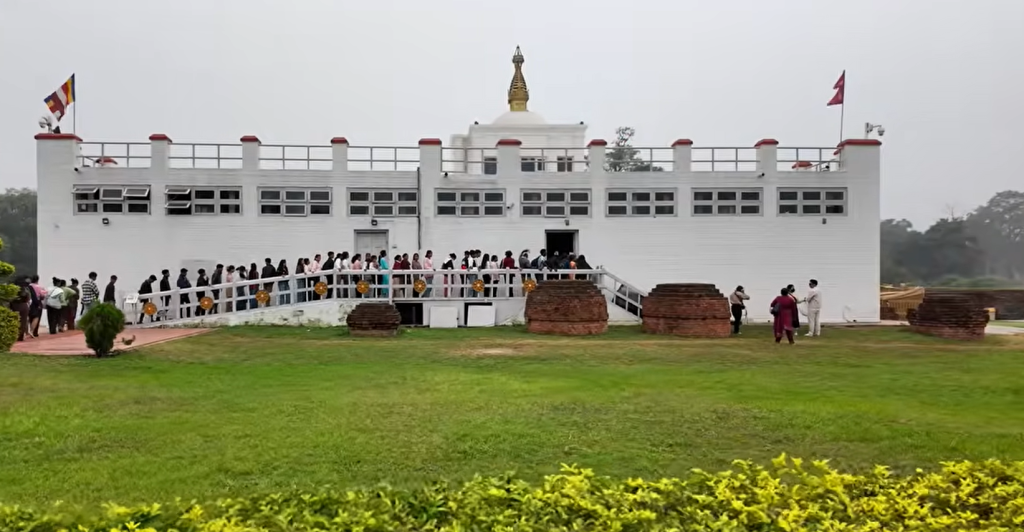
The Supreme Court of Nepal has issued a landmark verdict ordering the relocation or closure of polluting industries near Lumbini, the birthplace of Gautam Buddha and a UNESCO World Heritage Site. The decision comes after years of growing concern over severe environmental pollution threatening the Ashoka Pillar—the only historical evidence confirming Buddha’s birthplace.
The joint bench of Justices Kumar Regmi and Sunil Kumar Pokharel delivered the order on August 27, 2025 (Bhadra 11, 2082 BS), mandating that industries emitting dust, smoke, or carbon pollution within 15 kilometers east, west, and north of Lumbini’s protective wall—and up to the Indian border in the south—must be closed or relocated within two years.
“To ensure the long-term preservation of Lumbini, industries causing dust, smoke, or carbon emissions must be closed or relocated within the specified perimeter,” the verdict stated.
The Court also prohibited the establishment of new industries within this protected zone and instructed the government to provide incentives for tourism-friendly businesses in the vacated areas.
The Petition and Legal Battle
A public interest litigation was filed in 2018 (2075 BS) by senior advocate Prakash Mani Sharma and the Janahit Protection Forum, citing irreversible damage to the sacred site caused by nearby industries. The petition listed 32 defendants, including the Office of the Prime Minister and Council of Ministers, various ministries, the Lumbini Development Trust, UNESCO, and several industrial companies.
The verdict invalidates all government approvals for industrial establishment within the Lumbini Corridor since 2009 (2066 BS), rendering their registrations void.
Environmental Damage to Lumbini
Lumbini, home to over 1.6 billion Buddhists worldwide, has been under threat from cement factories, brick kilns, and other industries operating in the Bhairahawa-Lumbini Corridor. Reports indicate that harmful particles—such as gypsum, cement dust, and crystalline residues—have been eroding the Ashoka Pillar and damaging local agriculture, biodiversity, and heritage sites.
World Health Organization (WHO) data revealed that air pollution levels in Lumbini have reached 270 micrograms per cubic meter—11 times higher than the recommended limit. Studies show that the most severe pollution occurs between October and March.
Impact on Wildlife and Heritage
Lumbini is home to 210 bird species, including around 500 Sarus cranes—95% of Nepal’s population of this species. Environmentalists warn that pollution and industrial activities are causing their decline. Wetlands in the area, vital for migratory birds and rare plants, are also deteriorating.
“Industrial pollution in Lumbini is a serious threat to biodiversity, human health, and cultural heritage,” said Dr. Hem Sagar Baral, a noted ornithologist.
Tourism Under Threat
Lumbini attracts over 1.2 million tourists annually. However, heavy truck traffic, dust pollution, and industrial congestion near the main access routes have made travel difficult and tarnished the spiritual atmosphere.
“It’s disheartening to wear a mask while visiting such a sacred site,” said a Malaysian tourist, expressing frustration over the dusty roads.
Tourism has grown significantly since Lumbini was listed as a World Heritage Site in 1997, with over 16 million visitors recorded in the past 13 years. Prominent visitors include UN Secretary-General António Guterres and Indian Prime Minister Narendra Modi.
Economic and Industrial Concerns
Industrialists have expressed concerns about the ruling, citing over NPR 70 billion invested in the corridor and potential job losses for hundreds of workers. Major cement companies—including Arghakhanchi Cement, Goenka Cement, and Shree Ram Cement—fall within the restricted zone.
“Industries that comply with pollution control should be allowed to operate, but those that fail must relocate,” said Netra Acharya, President of Siddharthanagar Chamber of Commerce.
The Path Forward
The Supreme Court’s order gives the government two years to implement the relocation. It has also mandated creating green belts, peace parks, and meditation zones to align with Lumbini’s spiritual and natural essence.
Environmentalists and heritage conservationists welcomed the decision, calling it a “historic step to safeguard Buddha’s birthplace for future generations.”











